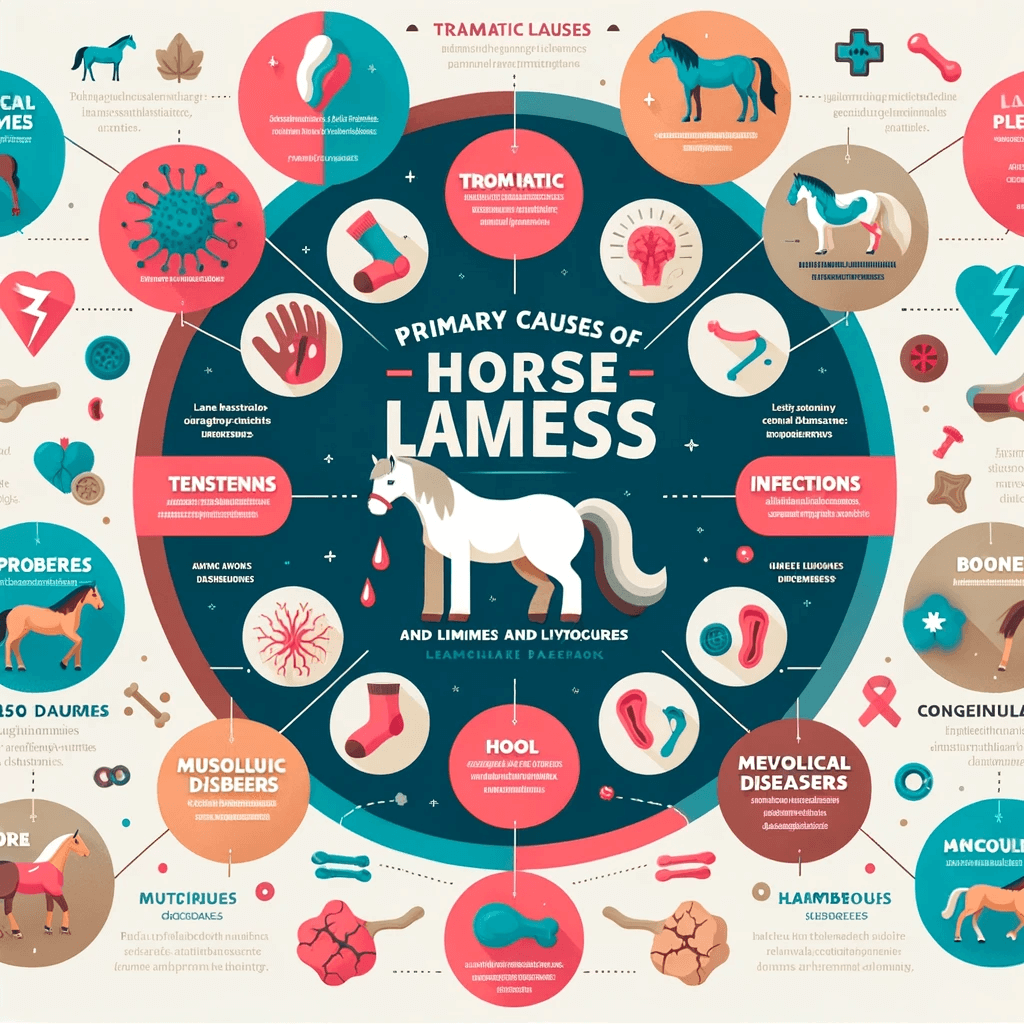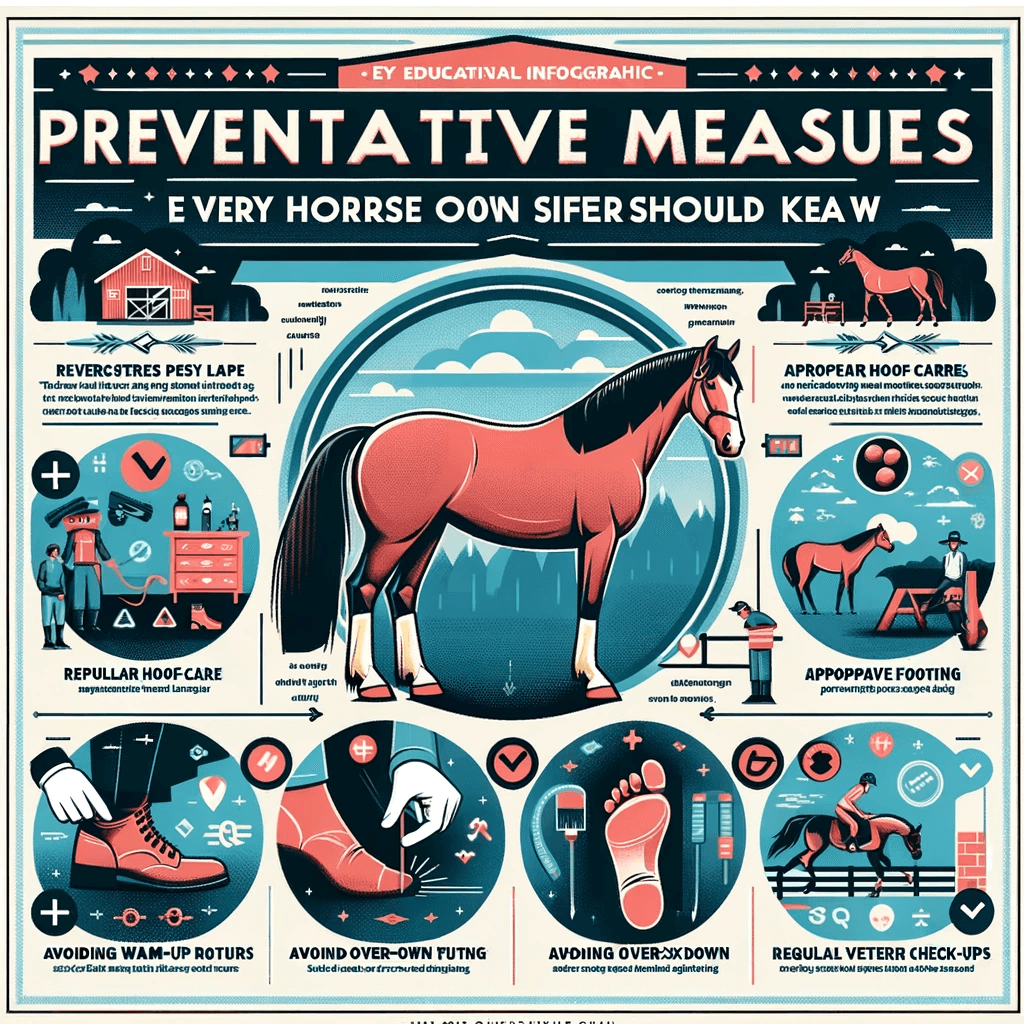Introduction:
In the vast world of equine health and care, lameness stands out as a significant concern for both novices and experienced horse owners alike. Much more than a mere physical ailment, lameness intertwines with the horse’s overall well-being, incorporating aspects of nutrition, psychology, and preventive care.
Every horse, regardless of its discipline or use, is susceptible to these issues, making it imperative for owners to grasp the multi-dimensional facets of lameness, its implications, and the best practices for prevention and recovery.
Read More: Fastest Horse In The World
What is Horse Lameness?
Horse lameness refers to an abnormality or deficit in a horse’s gait due to pain, injury, or a mechanical dysfunction in the musculoskeletal system. In simple terms, it indicates that the horse is either unwilling or unable to step normally on one or more of its limbs.
Lameness can range in severity, from being barely noticeable to the horse being unable to bear any weight on the affected limb. As it often signifies pain or discomfort, diagnosing and addressing lameness is crucial for the horse’s welfare.
Primary Causes of Horse Lameness:

Traumatic Injuries:
Direct trauma, such as kicks from other horses, falls, or collisions, can lead to bruising, fractures, or other injuries resulting in lameness.
Joint Issues:
Arthritis, joint inflammation, or degenerative joint disease can cause discomfort and lead to lameness.
Tendons and Ligaments:
Strains, sprains, or tears in the tendons and ligaments can make movement painful for the horse.
Hoof Problems:
Laminitis, abscesses, hoof cracks, or poorly fitted shoes can be significant contributors to lameness.
Infections:
Septic arthritis or osteomyelitis, which are infections in the joint or bone, can result in lameness.
Muscular Issues:
Muscle strains or myopathies can cause discomfort and changes in the horse’s gait.
Bone Diseases:
Conditions such as navicular disease or bone spavin can be underlying reasons for lameness.
Neurological Disorders:
Certain conditions affecting the horse’s nervous system can manifest as lameness.
Metabolic Disorders:
Some metabolic issues, like Equine Metabolic Syndrome, can indirectly result in lameness, especially if they lead to conditions like laminitis.
Congenital or Developmental Issues:
Conditions present from birth or developed early in life, like flexural deformities, can result in lameness.
Read More: Where Do Horses Come From
Recognizing the Signs and Symptoms:
Altered Gait:
The most evident sign is a change in the horse’s normal gait, such as limping or favoring one leg.
Head Bobbing:
Horses may bob their heads more prominently when they step on a sore limb.
Heat and Swelling:
The affected area, such as a joint or tendon, might feel warmer than normal and appear swollen.
Reluctance to Move:
The horse may be unwilling to move, run, turn, or bear weight on the affected limb.
Changes in Behavior:
The horse may become more irritable, depressed, or show signs of discomfort or pain.
Altered Stance:
The horse might rest a foot more often or shift its weight to other legs.
Response to Pressure:
A noticeable pain response when pressure is applied to a specific area.
Changes in Hoof Growth:
Uneven wearing or growth of the hoof might be a sign of long-standing lameness.
Read More: What Jobs Involve Horses
The Importance of Regular Veterinary Check-ups:
Regular veterinary check-ups play a pivotal role in ensuring the overall health and longevity of a horse. These check-ups are not merely routine visits; they act as a preventive measure to catch potential problems before they escalate. Here’s why:
Early Detection of Diseases:
Many equine ailments, when detected early, can be managed more effectively, reducing the risk of complications. Routine check-ups can catch underlying issues that might not yet manifest overt clinical signs.
Vaccination Updates:
Horses require periodic vaccinations against certain diseases. Regular vet visits ensure that these vaccines are administered on schedule, offering continuous protection.
Dental Health:
Equine dental problems can lead to weight loss, malnutrition, and other health concerns. Regular dental examinations and floating (smoothing of sharp edges) are essential.
Parasite Control:
Regular fecal exams and deworming strategies can be discussed and implemented during these visits, protecting the horse from internal parasites.
Nutritional Counseling:
Veterinarians can provide advice on appropriate diets based on the horse’s age, work level, and specific needs.
Baseline Health Records:
Regular check-ups provide a record of the horse’s normal health parameters, making it easier to detect deviations in the future.
Read More: Are Horses Ruminants
Diagnostic Procedures for Horse Lameness:
When a horse displays signs of lameness, veterinarians use a combination of techniques to determine the cause:
Lameness Examination:
The vet observes the horse’s gait at different speeds and on various surfaces. This helps pinpoint which limb or limbs are affected.
Flexion Tests:
By flexing a joint for a brief period and then immediately observing the horse trotting, any exacerbation of lameness can indicate a problem in that joint or the associated limb structure.
Palpation and Manipulation:
Feeling the horse’s limbs can help detect heat, swelling, or pain, giving clues about the injury’s location.
Radiography (X-rays):
X-rays can reveal bone changes, fractures, or joint conditions causing lameness.
Ultrasonography:
Ultrasound is useful for visualizing soft tissues, such as tendons and ligaments, to detect strains, tears, or inflammation.
Magnetic Resonance Imaging (MRI) and Computed Tomography (CT):
Advanced imaging modalities can provide detailed views of both bone and soft tissue structures.
Nerve and Joint Blocks:
By temporarily numbing specific areas, vets can isolate the lameness’s source.
Read More: Strangles In Horses
Treatment Options and Their Efficacy:
The treatment for horse lameness varies based on its cause and severity:
Rest and Rehabilitation:
Many minor injuries simply require time off from work and a structured rehabilitation plan.
Anti-inflammatory Medications:
Non-steroidal anti-inflammatory drugs (NSAIDs) like phenylbutazone can reduce pain and inflammation.
Physical Therapy:
Techniques like ultrasound, laser therapy, and massage can promote healing and relieve pain.
Joint Injections:
Steroids or hyaluronic acid might be injected into affected joints to alleviate discomfort and inflammation.
Surgery:
In some cases, surgical intervention may be necessary, for instance, to repair a torn ligament or remove bone chips.
Alternative Therapies:
Acupuncture, chiropractic care, and equine osteopathy are becoming popular adjunct treatments.
Shoeing Changes:
Proper hoof care and changes in shoeing can alleviate certain types of lameness.
The efficacy of these treatments depends on the exact cause of lameness, the horse’s overall health, and the timeliness of intervention. Regular veterinary check-ups can ensure early detection, leading to more successful treatment outcomes.
Rehabilitation and Recovery: Best Practices
The road to recovery after a lameness episode requires dedication and patience. Proper rehabilitation ensures the horse heals correctly and reduces the risk of re-injury:
Gradual Return to Activity:
Avoid rushing the healing process. Start with limited movement, like hand walking, before progressing to under-saddle work.
Structured Exercise Regimens:
Work with a veterinarian or equine physiotherapist to develop a structured rehab program tailored to the horse’s specific injury.
Continuous Monitoring:
Regularly inspect the injured site for signs of inflammation or discomfort and adjust the rehab program accordingly.
Hydrotherapy:
Swimming or underwater treadmills can allow movement without putting strain on healing structures.
Supportive Bandaging:
Proper bandaging can offer support to healing limbs and prevent swelling.
Preventative Measures Every Horse Owner Should Know
Prevention is always better than cure. Here are some measures every horse owner can adopt to reduce the risk of lameness:

Regular Hoof Care:
Routine trimming and shoeing by a qualified farrier ensure the horse’s hooves remain healthy.
Appropriate Footing:
Avoid working horses on extremely hard, uneven, or slippery surfaces.
Warm-Up and Cool-Down:
Always ensure your horse has a proper warm-up and cool-down during every exercise session.
Avoid Overexertion:
Know your horse’s limits and avoid pushing them too hard, especially if they are not conditioned for intense work.
Regular Vet Check-ups:
Early detection of potential issues can prevent many cases of lameness.
The Role of Proper Nutrition and Exercise
The overall health of a horse, including its musculoskeletal health, is deeply influenced by nutrition and exercise:
Balanced Diet:
Feed a balanced diet that meets the horse’s energy, protein, vitamin, and mineral requirements. Special attention should be paid to minerals like calcium and phosphorus, which play roles in bone health.
Maintain Ideal Weight:
Overweight horses have increased strain on their joints and tendons, making them more susceptible to injuries.
Consistent Exercise:
Regular exercise ensures that muscles, tendons, and ligaments remain strong and flexible.
Joint Supplements:
Ingredients like glucosamine, chondroitin, and hyaluronic acid can support joint health.
Psychological Aspects of Horse Lameness
Lameness doesn’t just affect a horse’s physical health; it can also have psychological implications:
Behavioral Changes:
A lame horse may display increased irritability, depression, or aggression due to pain.
Training Setbacks:
Time off from regular work can lead to a loss in training progress or the development of undesirable behaviors.
Social Dynamics:
Restricted movement can limit a horse’s interaction with herd mates, leading to loneliness or hierarchy challenges upon return.
Owner Connection:
A bond between horse and owner can be strained due to the stress of injury and rehabilitation. It’s crucial for owners to remain patient, empathetic, and consistent in their care.
Understanding and Managing Behavioral Changes in Horses During Lameness Recovery
Lameness in horses, a common issue in equine health, not only impacts their physical well-being but also significantly affects their behavior and mental state. During the recovery process from lameness, understanding and managing these behavioral changes is crucial for the horse’s overall recovery and well-being. This article delves into various aspects of these changes and provides insights into effectively managing them.
Identifying Behavioral Changes in Recovering Horses
Observing Subtle Signs:
Look for changes like reduced interaction with humans or other horses, indicating discomfort or anxiety.
Signs of Stress and Discomfort:
Watch for increased vocalization, pacing, or changes in eating habits as indicators of pain or stress.
Psychological Impact of Lameness and Confinement
Stress Due to Restricted Movement:
Acknowledge that limited mobility can lead to frustration and stress, manifesting as changes in behavior.
Coping with Isolation:
Implement measures like visual contact with other horses or increased human interaction to alleviate feelings of isolation.
Rehabilitation and Behavioral Management
Tailored Rehabilitation Programs:
Design rehabilitation programs that gradually reintroduce activities, preventing behavioral issues related to abrupt changes.
Maintaining Mental Stimulation:
Engage horses with puzzle feeders or gentle grooming to keep them mentally active during recovery.
Strengthening the Horse-Owner Bond During Recovery
Building Trust and Patience:
Spend quality time with the horse, using gentle grooming or quiet companionship to strengthen the bond.
Positive Reinforcement Techniques:
Use treats or affection to reward calm and cooperative behavior, reinforcing positive interactions.
Conclusion:
Navigating the challenges posed by horse lameness requires a harmonious blend of attentive care, knowledge, and a proactive approach. Beyond the immediate physical implications, the ripple effects of lameness on a horse’s mental state, nutritional needs, and overall lifestyle underscore its complexity.
By recognizing the holistic impact of lameness and arming oneself with comprehensive care strategies, horse owners can not only address the issue effectively but also foster an environment where their equine companions thrive in health and happiness.
FAQs:
How often should I check my horse for signs of lameness?
Regular observation is key. Check your horse daily, especially after exercises or long rides, and be vigilant about any changes in their gait or behavior.
Can a horse recover fully from lameness?
Yes, with the right diagnosis, treatment, and care, many horses can recover fully. However, the extent of recovery can vary based on the cause and severity of lameness.
How can I prevent lameness in horses?
Regular veterinary check-ups, a balanced diet, proper exercise, and attention to the horse’s environment can significantly reduce the risk of lameness.
Does shoeing or hoof trimming play a role in preventing lameness?
Absolutely. Proper hoof care, including regular trimming and shoeing when necessary, can help in preventing many issues related to lameness.
